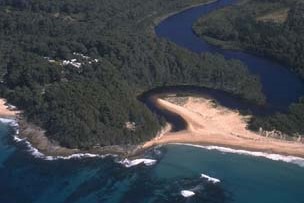Willinga Lake is small coastal lagoon with an intermittently closed entrance. It is located on the south coast on New South Wales and enters the ocean just north of the boundary of Batemans Marine Park.
Water quality report card
As part of our water quality monitoring program we assess the water quality and ecosystem health of an estuary using a range of relevant indicators. We sample a subset of the estuaries between Wollongong and the Victorian border every 3 years. The most recent sampling in Willinga Lake was completed over the 2014–15 summer, when 2 sites were sampled on a monthly basis.
This report card represents 2 water quality indicators that we routinely measure: the amount of algae present and water clarity. Low levels of these 2 indicators equate with good water quality.
Algae
Water clarity
Overall grade
The report card shows the condition of the estuary was fair with:
- algae abundance graded fair (C)
- water clarity graded fair (C)
- overall estuary health graded fair (C).
Grades for algae, water clarity and overall are represented as:
- A – excellent
- B – good
- C – fair
- D – poor
- E – very poor.
Go to estuary report cards to find out what each grade means, read our sampling, data analysis and reporting protocols, and find out how we calculate these grades.
We have monitored water quality in Willinga Lake since 2011. This table shows the water quality grades for this estuary over that time.
| Year | Algae | Water clarity | Overall grade |
|---|---|---|---|
| 2011–12 | C | D | C |
Physical characteristics
| Estuary type | Back-dune lagoon |
|---|---|
| Latitude | –35.5 (ºS) |
| Longitude | 150.39 (ºE) |
| Catchment area | 13.6 km2 |
| Estuary area | 0.3 km2 |
| Estuary volume | 94.6 ML |
| Average depth | 0.3 m |
Notes: km2 = square kilometres; m = metres; ML = megalitres.
Water depth and survey data
Bathymetric and coastal topography data for this estuary are available in our data portal.
Land use
The catchment of Willinga Lake is moderately disturbed, with 20% cleared for grazing and urban land use at Bawley Point. Over 70% of the catchment is forest, some of which lies in Meroo National Park and Murramarang National Park.
National and marine parks
- Meroo National Park and Murramarang National Park are the largest conservation areas in the Willinga Lake catchment.
- There is no marine park associated with this estuary, but the estuary entrance opens to the ocean just north of the boundary of Batemans Marine Park.
Citizen science
- The Budawang Coast Nature Map is an online data platform the community can use to record and identify biodiversity. Data collected is used to map the distribution of native plant and animal species from Moruya up almost to Kiama.
- The South Coast Shorebird Recovery Program provides the opportunity for people to get involved in the protection and recovery of shore birds.
Community involvement
- Shoalhaven Landcare Association is a volunteer community-based conservation group.

Aerial view of Willinga Lake
Local government management
Local councils manage estuaries within their area unless the estuary is attached to a marine park.
Shoalhaven City Council manages this estuary.
Threatened species
Estuaries are important to our native animals as they provide food, shelter and breeding grounds.
Read more about the biodiversity in our estuaries.